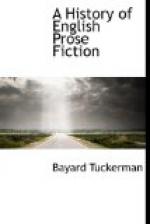Miss Edgeworth has been ably followed by several students of Irish life. William Carleton’s “Traits and Stories of the Irish Peasantry,” the novels of Samuel Lover and of John Banim are still well known. Thomas Crofton Croker, with whose amusing description of the “Last of the Irish Sarpints,” the reader is probably familiar, has studied his countrymen’s superstitions and peculiarities with great success. Charles James Lever has long retained a well-deserved popularity by the production of about thirty jovial dashing novels, among which the most celebrated is “Charles O’Malley, the Irish Dragoon."[205]
[Footnote 205: Among other novelists of Irish life and manners may be mentioned Lady Morgan, Mrs. S.C. Hall, Gerald Griffin, T.C. Grattan, Justin MacCarthy, and others.]
V.
Novels relating particularly to English life and manners have been greater in number and more varied in character than those of any other country. A large volume would be necessary to do any critical justice to the many distinguished writers whom we can only briefly notice here. The most considerable subdivision of the English novel has been that occupied with the study of domestic life,—a department for which women are particularly fitted, and in which they have been eminently successful.
Mrs. Opie’s “Simple Tales,” “Tales of Real Life,” and “Tales of the Heart,” although displaying no great talent in construction or style, excel in a natural pathos and a delicacy of sentiment which have made them popular for many years. Miss Edgeworth brought to the study of English life the same practical views and library talents which we have seen in her Irish novels. Her children’s stories, “Frank,” “Harry and Lucy,” and “Rosamund” were among the first contributions to juvenile fiction. “Helen,” in which she exposed the evils of untruthfulness, is a good example of the success with which this admirable woman could combine entertainment and moral elevation. Jane Austen’s name has long been linked with that of Miss Edgeworth, as the two most powerful female novelists of the earlier part of the century. In “Pride and Prejudice,” “Emma,” “Mansfield Park,” “Sense and Sensibility,” she described the country gentry and middle classes of society. She depended neither on exciting scenes, nor on highly wrought effects of human passion for the interest of her stories, but studied every-day life and ordinary people with a sympathy and power of observation which imparted a deep interest to all her works. Miss Ferrier’s novels, “Inheritance” and “Marriage,” were greatly admired by Scott, and now, some sixty years later, are still widely read, and receive the honor of both cheap and expensive editions. Miss Ferrier’s skill in the construction of a plot, her natural studies of character and the liveliness of her descriptions have kept her works popular, notwithstanding great changes in the public taste. Mrs. Trollope, the




